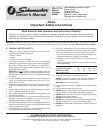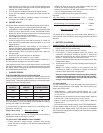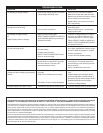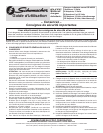
4
TIMER
The timer is designed to allow the battery to be charged for a desig-
nated amount of time. To accurately charge your battery, you must
know the size of the battery in ampere hours or reserve capacity
in units, as well as the state of charge. Since this information is not
known by the charger, the timer limit is set at 2.25 hours to prevent
the battery from overcharging to a point where it can be severely
damaged. If you do not know the charge state of your battery, set
the timer at one hour or less.
TO SET THE TIMER:
1. Press the t symbol for less time and the symbol for more
time.
2. The Timer LED will light and digital display will show the time
in minutes.
3. To turn the timer off, press the t symbol until the digital display
reads OFF.
TIMER HOLD
The Timer Hold feature overrides the timer allowing the charger to
continue charging for over 2.25 hours. This feature is most often
used when the charging rate is 2 or 20 amps. Using this feature
requires closely monitoring the charge time and turning off the
charger when the battery is fully charged.
NOTE: When the battery is fully charged, the charger and timer
will not automatically turn off. It is important to monitor the charge
level. Not doing so may cause damage to your battery.
TO ACTIVATE THE HOLD FEATURE:
1. Press the t symbol until the Digital Display reads HLD.
2. To release the Timer Hold, press the until the digital display
reads OFF.
BATTERY TEST
The Battery Test is based on the terminal voltage of the battery. If
the battery is installed in the vehicle, make sure the engine and all
accessories are turned off before testing.
1. Plug the power cord into a 3-prong electrical wall outlet.
2. Press the SELECT DISPLAY MODE button and select
VOLTAGE.
3. Hook the battery clamps to the battery as outlined in “Charging
Your Battery” on page 3.
4. The digital display will show the voltage of the battery:
12V BATTERY VOLTAGES
12.8 or more volts = Charged battery
12.8 – 12.2 volts = Battery needs charging
12.2 or less volts = Discharged battery, needs charging
6V BATTERY VOLTAGES
6.4 or more volts = Charged battery
6.4 – 6.1 volts = Battery needs charging
6.1 or less volts = Discharged battery, needs charging
G. OUTPUT SELECTOR CONTROLS
NOTE: If, after charging, the battery does not hold a charge, have
the battery tested by a qualied technician.
BATTERY/ALTERNATOR TEST
1. Plug the power cord into a 3-prong electrical wall outlet.
2. Press the SELECT DISPLAY MODE button and select
VOLTAGE. (The digital display will show the voltage of the
battery.)
3. Hook the battery clamps to the battery, as outlined in “Charging
Your Battery” on page 3.
4. Start the engine and while it is at a fast idle, read the digital
display.
NOTE: The battery should be in a good state of charge before
doing this test.
12V ALTERNATOR/GENERATOR DISPLAY
15 volts or more = See vehicle owner’s manual
15 – 14 volts = Good condition
14 - 12.8 volts = See vehicle owner’s manual
12.8 or less volts = Check with qualied technician
NOTE: If the digital display reads less than 12.8 volts, the charging
system may have loose fan belts, a defective voltage regulator or
alternator. Additional tests may be required to nd the exact cause.
Take the vehicle to a qualied service center.
6V ALTERNATOR/GENERATOR DISPLAY
7.5 volts or more = See vehicle owner’s manual
7.5 – 7 volts = Good condition
7 - 6.4 volts = See vehicle owner’s manual
6.4 or less volts = Check with qualied technician
SELECT VOLT/CHARGE RATE
The SELECT VOLT/CHARGE RATE allows you to select the correct
battery voltage and amp draw rate to match your charging needs.
Read the following operating instructions for making the proper
settings for charging a battery.
When you rst start charging a battery, the amp reading will be high.
As the battery becomes charged, the reading will decrease.
To determine the amount of amps being drawn by the battery:
1. Press the SELECT DISPLAY MODE button until the AMPS
LED lights.
a. As the battery charges at 40 amps, the reading will decrease
to 15 or 20 amps at full charge. You should stop charging
the battery at this time.
b. When charging at 20 amps, the display should show 15
amps for a discharged battery and 7-8 amps for a fully
charged battery. You should stop charging the battery at
this time.
c. At the 2 amp charge rate, little or no display change will
occur.
NOTE: The digital display will read OL or Overload if
more than 40 amps are supplied to the battery. Overload
means too high a charging rate. Lower the charging rate
to continue.
To determine an accurate reading of your battery’s voltage before
you charge:
1. Plug the power cord into a 3-prong electrical wall outlet.
2. Press the SELECT DISPLAY MODE button so the VOLTAGE
LED lights.
3. Connect the battery charger as outlined in “Charging Your
Battery” on page 3. The voltage will be displayed.
NOTE: If a battery has recently been charged or in a vehicle
DIGITAL
DISPLAY


















